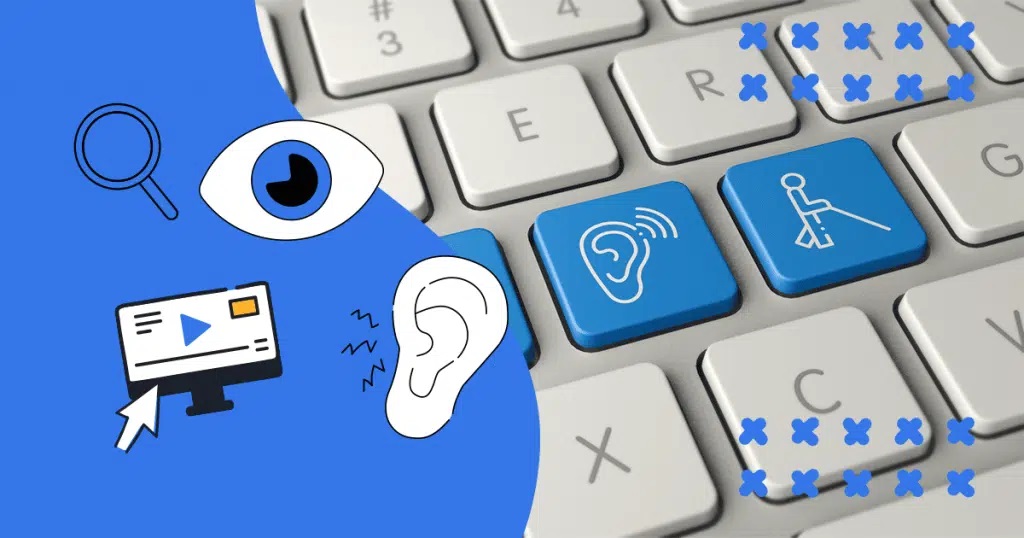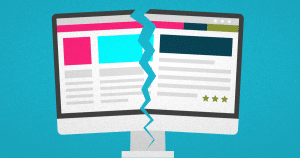Trying to access crucial information online is a problem that happens daily for more than one billion people with disabilities worldwide.
Today, 15% of the world’s population experience some type of disability. Despite accessibility becoming a priority for many companies over the last few years, when it comes to digital accessibility, brands still have a long path ahead.
A survey by the English company Click-Away Pound showed that 69% of respondents abandon websites due to a lack of accessibility. In addition, 86% said that they would spend more if online stores were affordable.
So, here’s the ugly truth for businesses: whoever is not thinking about this subject is not just impeding people from having free access to information and services on the internet, but is also losing money.
Digital accessibility means breaking down barriers on the internet for people with disabilities. In other words, it’s the ability for a piece of content or online experience (whether it’s on mobile or desktop) to be fully understood by users who have disabilities — regardless of whether it’s visual, hearing, physical or cognitive.
Digital accessibility best practices range from code improvements that allow screen readers to read, for example, to the inclusion of alternative text in images and videos that describe behaviors.
According to a study conducted by WebAIM in 2020, the vast majority (98%) of websites and tools are designed without considering the different types of disabilities and end up offering a poor and incomplete experience for them.
Where does Marketing fit into this scenario?
According to the Purple Pound, in the UK, businesses lose about £2 billion a month by ignoring the needs of people with disabilities.
An article published in 2018 by the American Institutes for Research said that, in the US, the estimated total income of people of working-age with disabilities was around US$500 billion. Of course, these people will most likely spend their money on platforms whose experience is more accessible to them. And it doesn’t stop there: according to Forbes, 70% of millennials say they deeply consider a company’s values before making a purchase. So yes, it’s undeniable: your brand needs to be aware of this issue and take action against it.
Talking about strategy, we know that, today, Marketing that generates results is centered on the user experience. Digital accessibility came not only to allow full access to digital experiences for people with disabilities but also to improve the audience experience as a whole.
Therefore, while accessible digital content is a necessity for part of the public, it also benefits other groups, such as people with a slow internet connection, small screens such as cell phones and smartwatches, and people who have suffered an accident (a broken arm, for example).
Also: it impacts SEO.
You know that Core Web Vitals algorithms from Google are all about user experience, right? It means you have to provide great navigation for all.
So the removal of barriers added to the improvement of the user experience and a greater reach of your content will certainly contribute to your pages ranking better on search engines.
Accessibility as a legal duty
In recent years, governments and policymakers worldwide have realized that to create a society with equity and justice, laws are needed to protect people with disabilities not only in the physical environment but also in the digital environment.
Considered the global standard, the most recent version of the Web Content Accessibility Guidelines — which is the WCAG 2.1 from June 2018 — establishes three levels of accessibility (to learn more, you may consult the WCAG website).
Level A
Level A is the most basic level, where all accessibility criteria considered as Priority 1 are met. It means that the site offers basic access to the content of the pages and documents online.
Level AA
At this level, the accessibility criteria of Priorities 1 and 2 are met. The site offers a higher level of usability and access to information contemplated in level A.
Level AAA
This is the final level, where all accessibility criteria from Priorities 1, 2, and 3 are covered. An AAA-level website provides excellent access to information through an optimal level of usability.
In addition to the classifications, WCAG 2.1 states that if a technology is not adaptive or does not support accessibility settings, an HTML alternative must be provided. In any case, a single and fully accessible version is always better.
It is worth mentioning that version 2.1 is an extension of 2.0. So if your website complies with the latest version, it will also comply with the previous one.
In the US, the Americans with Disabilities Act (ADA) establishes digital accessibility requirements for several industries. Some large companies have already been sued for not complying with legislation, such as Netflix, Nike, and Burger King.
So, above all, following WCAG guidelines will help your company stay ADA compliant and avoid legal fees.
Our path to digital accessibility
Rock Content is a company committed to Diversity and Inclusion. That’s why, in May, among other strategies, we released new accessibility settings for Ion, our platform that provides interactive content, pages, and experiences.
Automatic and manual features were implemented. Automatic settings are updates on the Ion code that have transformed some points to make the experiences easier for screen reader tools to read.
Manual settings are improvements that the user can implement when creating an interactive experience, for example adding alt text to images.
With these improvements, Ion users can now create accessible and compliant interactive experiences for their audience.
The internet and its immensity of content are at the center of user decision-making: in research, evaluation, and purchase. Providing equitable access to these resources is more than a legal obligation or a sales strategy; it is a moral duty to the billions of people who are people with disabilities.
Governments, institutions, and companies around the world already recognize the positive impact of implementing changes based on accessibility guidelines.
More than complying with the law, investing in digital accessibility is also a way to differentiate yourself from your competitors. You can ensure a smooth and complete journey for users and exceed expectations by creating attractive digital experiences and allowing everyone to equally enjoy the benefits of the digital age.
This article is also in the new issue of Rock Content Magazine, released this August. In this issue, we bring incredible content about diversity, inclusion, and accessibility, an extremely important topic for brands and society today. You can download the magazine here, it’s completely free! Happy reading!








